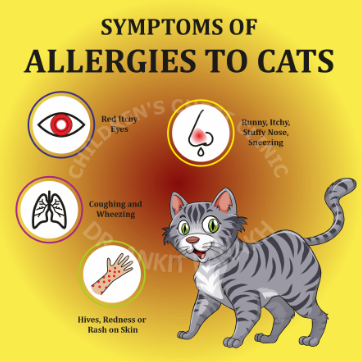Although some people avoid cats because they fear or dislike them, there is some hope for those who avoid cats because of fear of allergic reactions. A lot will depend on the nature of your allergies. If yours are of the sneezing, watery eyes, and running nose variety, you may be able to slowly and gradually build up your tolerance to cats.
:strip_icc():format(webp)/controlling-cat-allergies-553869_V1-25c566bdc67342ceadfb85a8326e8976.jpg)
However, before getting a cat, you should undergo allergy testing first, particularly if you suffer from asthma. For example, about 30 percent of people with allergies are allergic to cats and dogs, but studies show the rate of cat allergies is actually far higher than that.
Here are tips to help you gain control over your cat allergy symptoms while enjoying the lifelong companionship of a feline.
It’s tough to miss cat allergy symptoms. They tend to happen whenever there’s a feline nearby or you’ve encountered some cat hair lingering on furniture. Your body’s immune system is reacting to the proteins that are found in a cat’s urine, saliva, or dander. Here is a list of typical cat allergy symptoms you may experience:
- Sneezing
- Coughing
- Wheezing
- Skin rash
- Nasal congestion
- Trouble breathing
- Runny/stuffed nose
- Itchy, red, watery eyes
:strip_icc():format(webp)/controlling-cat-allergies-553869-10-92418e286a4c4853b923d057c8b7c3c4.jpg)
If you’re considering bringing a new pet into your home, first rid your home of as many other allergens as possible, including mites, dust, and mold. Most airborne allergens (including cat dander) cling to soft material such as curtains and drapes, upholstery, and floor coverings. Here are common ways to clear your home of allergens:
- Substitute blinds for window coverings. If you rent, and can’t get permission to switch them, keep the curtains washed and frequently vacuum the drapes.
- If possible, replace overstuffed upholstered furniture with leather.
- Eliminate decorative scented candles, potpourri, and plug-in air fresheners, all of which can exacerbate allergy symptoms.
- Consider replacing wall-to-wall carpeting with wood or tile floors. Otherwise, thoroughly vacuum carpeting regularly.
Medication is often the first thing people consider when dealing with a cat allergy. Over-the-counter or prescription medication, natural remedies such as BioAllers, or a series of allergy shots (immunotherapy) are all worth investigating. Keep in mind that you should always check with your physician or allergist before embarking on a new treatment.
Choose to visit a friend with an outgoing cat to allow you to get up close and personal with a feline, but on a limited basis. Ask your friend to choose a time when the cat is fed, comfortable, and relaxed. Ask your friend permission to use an allergy relief spray or wipes on the cat if necessary while you’re visiting.
Use your allergy medication half an hour before the arranged time. When you arrive, let the cat set the pace. You may be greeted by being sniffed at your feet and legs at first. You can dangle your hand to see if the cat rubs up against it, which can indicate petting is acceptable. If your allergies are still under control, you might allow the cat to jump onto your lap. Make your visit about 15 minutes at the most to keep both you and the cat comfortable.
In another week or two, visit again with the same cat, and stay longer, up to half an hour. Begin to branch out and visit other friends with cats.
There are a few breeds of cats considered to be hypoallergenic, or at least helpful to those with allergies, including the following breeds:
- Sphynx: These cats have very fine, sparse hair.
- Rex: Certain rex breeds, like the Devon Rex have fine, wavy or curly hair that may not trap dander the way thicker coats do.
- Siberian: These cats lack the Fel d 1 protein in their saliva that becomes dander after grooming, a characteristic that may be good for those with allergies.
To find out more information about these specific breeds, see if there’s a local cat show you can attend where you can observe them. Many cat breed clubs hold shows highlighting individual breeds.
Once you feel that your allergies are under control, consider adoption. Here’s how to navigate a trip to your local animal shelter or a cat adoption event.
- Dress in comfortable, casual clothes.
- Remember to take any allergy medications beforehand.
- Prepare to spend an hour or so at the shelter or event.
- Take a few cats, one at a time, into a private room, if available, and spend some time with each one.
It’s often been said that cats usually chose their humans, so let a cat’s actions guide you in your choice. You may need to visit the shelter several times before you find the cat that fits your lifestyle.
Make sure your home is completely prepared for a new pet. Once you have made your choice, talk to the personnel, tell them about your allergies, and ask if the cat may be returned, as a last resort, if your allergies are aggravated once you bring the pet home. Try to restrict your new cat from going into your bedroom so you can sleep free of even the faintest of allergy symptoms.
Once you get your cat home, consider feeding a specific allergen-reducing cat food called Pro Plan LiveClear. This diet has been scientifically proven to decrease the Fel d 1 allergen in cat dander. Also, routine wiping of your cat’s fur with baby wipes or damp cloths will also help decrease dander spreading.
Cats are amazing creatures and hopefully, with advancements in allergy medications, feline diet control and routine coat maintenance, you can enjoy a feline friend even with allergies.
DISCLAIMER: The information contained in this article is for educational purposes only, and should not be used as a substitute for personal care by a licensed physician. Please see your physician for diagnosis and treatment of any concerning symptoms or medical conditions.



:strip_icc():format(webp)/controlling-cat-allergies-553869-13-d82862753bed403d84cb43881fad2528.jpg)








